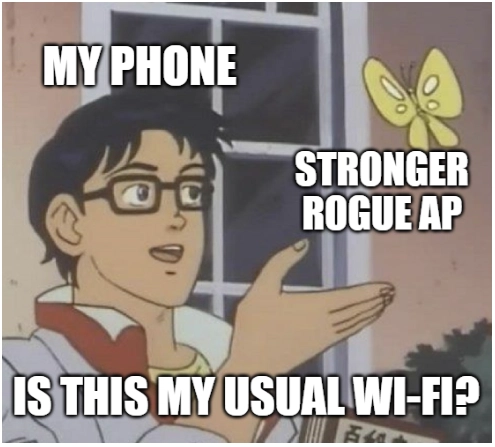„Is this really Starbucks Wi-Fi… or a trap?“
Public Wi-Fi is convenient — but it could also be dangerous. Imagine you’re sitting at a café, sipping coffee, and scrolling on your phone. You connect to a network named Starbucks_WiFi without thinking twice. But what if that network wasn’t real? What if it was set up by a hacker just a few feet away?
Welcome to the world of Evil Twin Attacks — a stealthy and surprisingly common form of cyberattack.
😈 What is an Evil Twin Attack?
An Evil Twin Attack is a type of Man-in-the-Middle (MITM) attack where a malicious actor creates a fake Wi-Fi access point (AP) that mimics a legitimate Wi-Fi network’s name (known as Service Set Identifier or SSID for short) and appearance.
When you connect to this rogue AP, the attacker can:
- Intercept your traffic
- Steal login credentials
- Redirect you to phishing websites
- Inject malware into downloads
In short, they’re silently eavesdropping between you and the internet, watching and manipulating your connections.
🧠 How Does It Work?
Here’s a simplified breakdown of the attack process:
1. The Setup
The attacker configures a Wi-Fi access point using the same SSID as a legitimate one — often something like Airport_Free_WiFi or Hotel_Guest.
2. The Bait
Devices that have previously connected to that SSID may auto-connect to the stronger signal — potentially the attacker’s AP if it’s closer.
3. The Trap
The attacker may serve a fake login page asking for credentials or silently proxy your traffic — essentially having access to any confidential data you send out.
4. The Exploit
Any unencrypted data sent through the fake AP can be logged or modified.
🔎 How to Spot an Evil Twin
Malicious actors would often target popular public hotspots in cafés and airports – areas with high density of devices likely seeking for free Wi-Fi – where it is easy to blend in and set up a rough AP in seconds.
It’s not always obvious — but here are red flags to look for:
🚩 Duplicate SSIDs with varying signal strengths
An attacker will often clone the SSID of a legitimate public Wi-Fi (e.g., Starbucks_WiFi) to make their rogue network look authentic. But because they’re physically located in a different spot than the real router, the signal strength will be noticeably stronger or weaker, depending on your proximity.
🚩 No encryption (open networks with no 🔒 icon)
Legitimate networks, even in public, increasingly use WPA2/WPA3 encryption. If you see an open network (i.e. no password required) that mimics the name of a secured one, it could be an Evil Twin trying to sniff, intercept, and/or modify unencrypted traffic.
🚩 Unexpected captive portals asking for logins
Some rogue APs use fake captive portals — web pages that pop up when you connect, prompting you to „log in“ to access the internet. These are commonly used for phishing credentials.
🚩 Frequent disconnections and reconnects
Attackers may force your device to disconnect from legitimate Wi-Fi in order to get it to connect to their rogue AP. This is done using deauthentication attacks.
🚩 SSL/TLS warnings in the browser (⚠️)
If you get a warning like Your connection is not private, that’s a big red flag because browsers show warnings when certificates don’t match. If you see these while on public Wi-Fi, your connection may be susceptible to malicious acts.
🛡️ How to Protect Yourself
You don’t need to be a hacker to defend yourself. Here are practical tips:
🔐 Use a Virtual Private Network (VPN)
Encrypts your traffic from your device to the VPN server, shielding it from local snooping.
🔐 Avoid public Wi-Fi
Prefer mobile data when accessing sensitive services (banking, email). If you must connect to one, treat the network as untrusted — avoid logging into sensitive accounts.
🔐 Disable auto-connect
Most operating systems allow you to turn off auto-join for public networks.
🔐 Use HTTPS Everywhere
Ensure sites you visit are encrypted (look for the 🔒 icon).
🔐 Use strong Wi-Fi security at home/work
Enterprises should adopt WPA3 + RADIUS and monitor for rogue APs.
👨💻 For Developers and Cybersecurity Enthusiasts
If you’re interested in going beyond theory, here are hands-on exercises to deepen your understanding of Evil Twin Attacks and network security. These are intended for ethical learning in controlled environments — never use these techniques on networks or devices you don’t own or have explicit permission to test.
1. Set Up an Evil Twin Access Point
Follow a guided tutorial like Cybrary's Evil Twin Attack Tutorial or similar walkthroughs using tools like airbase-ng and Fluxion.
📌 Goal: Understand how easy it is to spoof public networks and trick devices into connecting to spoofed networks.
2. Capture and Analyze Traffic Using Wireshark
Run Wireshark to observe unencrypted HTTP traffic, DNS requests, as well as visible credentials or session cookies (especially in insecure apps).
📌 Goal: See firsthand how unencrypted data travels across open Wi-Fi and why HTTPS and VPNs are critical.
3. Explore the MITRE ATT&CK Framework
Read about Technique T1557.002: Rogue Wireless Access Points and map the Evil Twin attack flow to MITRE’s stages (Reconnaissance → Initial Access → Credential Access).
📌 Goal: Gain a structured understanding of how attackers use wireless access as part of a larger kill chain.
🧾 Final Thoughts
Evil Twin Attacks are deceptively simple, yet dangerously effective. And as we grow increasingly reliant on wireless connectivity, cybersecurity awareness is no longer optional — it’s essential.
✍️ Have you ever suspected a rogue network? Share your experience or thoughts in the comments below!





